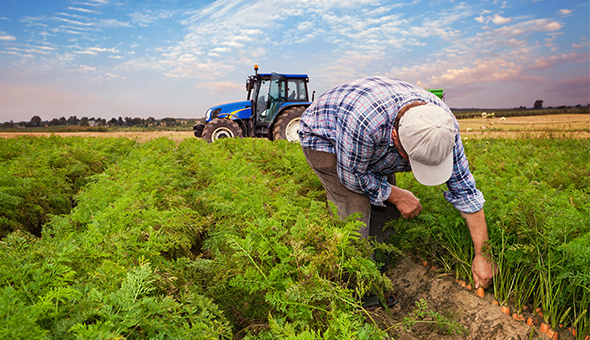5 key talking points #SAIPlatform2021
28th June 2021

Recognising the value of agriculture for a thriving future was the theme for SAI Platform’s first online annual event. Sustainability leaders and experts from around the world came together to discuss some of the big topics trending in the agri-food industry on sustainability. Conversations focused on regenerative agriculture, the need for financial incentives and good legislation and why collaboration is as important now as ever.
1. What is regenerative agriculture?

Farmers like Trey Hill, Owner and Manager of Harborview Farms, prefer using terms such ecological farming or regenerative farming because “there isn’t enough room to change and evolve in the definition of the word sustainability.”
For Sarah Mock, freelance agricultural writer, the last 2 years, have seen many farmers moving from climate change deniers to leading the change. “Since then, the umbrella of what regenerative agriculture is has expanded and perhaps even devolved to include almost everything and this makes it challenging.”
Aside from preference of terminology, regenerative farming adds complexity and risk, which is perhaps why farmers have been slow to adopt these practices. Carbon markets are a steppingstone but are still not adding enough value for farmers to offset these complexities and risks.
James Ede from Cargill believes that “It’s about system change, not just practice adoption … it’s ecosystem services and the benefits of specific practices across the whole picture”.
He outlines that there are many different approaches and focuses, such as collaborating with other partners and being able to give farmers the confidence that it works. In James Ede’s case, he is directly connected to farmers on the one side and then his customers on the other. This helps with collaborations across supply chains and with the right messaging and communications, helps farmers to better understand.
Already, several SAI Platform members are undertaking pilot projects related to regenerative agriculture. Examples include Danone with strawberries in Mexico and around the world; Unilever with wheat in the US; FAI Farms transitioning their beef farms to regenerative in the UK and Synlait transitioning to regenerative dairy farms in New Zealand. The Soil Health Institute and Cargill are also building practical approaches to regenerative agriculture that gives farmers confidence that it works on their farms.
2. The most important objective of regenerative agriculture is building soil health
According to the poll, the consensus in the room was that building soil health was the most important objective for regenerative agriculture followed quite some way behind by increasing crop resilience. Another poll showed results that regenerative agriculture is first seen as a positive contribution to the environment followed by how it benefits profits.
In the case of Alfonso Chico de Guzmán, Farmer and President of AIVelAI, the change to more sustainable or regenerative agriculture practices pivots on two factors. Firstly, customers will need to pay more for produce that is grown in a certain way and that can be traced and secondly, the incentive that as a family business, farmers want to be able to pass their farm onto the next generation.
3. Farming is a business not just a lifestyle choice
Sarah Mock explained why change is not already happening and that scaling up is hard because “There is this underlying perspective that if we pay farmers more, they will change, but that is not the case. There are many other influences that affect how farmers operate”.
Transition and change require an entrepreneurial approach from farmers and for Sarah Mock, those that are not prepared to change and evolve operationally, will go out of business.
From her perspective farmers who are most likely to engage are those that think of their farm as a business instead of only a lifestyle; typically, these will be the more progressive ones. One thing that industry can do is to focus on the farms that are farmed as businesses.
4. The real drivers for food system transition

Incentives are key to food system transition and according to Sarah Mock, a voluntary environmental approach is not working at the scale needed.
From the farmers’ perspective, Elijah Perkins, Purchasing – Field Agent at Norwest Ingredients stated that profitability and more business are the drivers when it comes to change. Trey Hill pointed out that farmers are not going to change and do something completely new and complex when their business model is already working. A small margin of extra profit is not enough to make them change their behaviour and accept the risks and complexity that comes with it.
The power of the purchase order and agronomy support that builds knowledge, behaviour and practice to the benefit of the farmer are key factors to add pressure and incentivise for change.
Reflecting on the role of companies in food system transition, David Pendlington, from Mars, said, “The world we want tomorrow starts with business today”.
“As a business the biggest difference is through the way you buy materials and there’s an ever-diminishing operating space in our planetary, social and sustainability boundaries.”
He emphasised that companies need to consider the total cost of ownership, from end to end and the impact of buying. Companies cannot only look at cost, but instead must internalise all the externalities. This underpins the statement that the key drivers are company reputation and supply security and that businesses must acknowledge the true cost of commodities but also recognise the benefits to companies who source sustainably.
From a legislative perspective, Francesco Tramontin, Ferrero has observed a new dynamic between policy makers and agri-business. Businesses need good regulation and the advice from David Pendlington, was that “If you see where the policy is going, then head there.”
Talking on behalf of the European Commission, Claire Bury, Deputy Director-General for Food Safety and Sustainability, DG SANTE, sees the Farm to Fork strategy as an opportunity to set the direction towards a more sustainable agri-food system. Companies must integrate sustainability and risk assessment and adopt sustainability practices to address those risks. However, the Commission also recognises that food actors need incentives and finance as well as support in the transition through innovation and digitalisation are needed.
“If we can make our standard a global standard for sustainability this could become the trademark of what we do in Europe.”
Caution, however, was raised by Alan Johnson, International Finance Corporation (IFC) that there is a risk of lack of communication of new EU green deal regulations that may have unintended consequences for growers outside of the European Union.
Society is also a key driver. Reputation was polled as the leading driver for businesses on sustainability strategies. For farmers, societal pressure also plays a part. In Trey Hill’s case, social pressures were important, but the more remote you are, it’s the grocery stores that need to apply the pressure.
So, is this transition imminent? Alan Johnson is optimistic as he sees a change going on. Sustainability is not on the fringe anymore but is instead becoming more mainstream. However, he added that “…to avoid legislation that drives a binary system whereby you’re either in or out, you need to be in and engaging with everyone and that includes the controversial.”
5. “Even if someone said no the first time, reach out again as things may have changed for them.”

The resounding message that collaboration is central to progressing sustainability goals was loud and clear. Collaboration begets more collaboration, and it is here that SAI Platform can play an instrumental role in helping to engage, facilitate and expand the ability of collaboration to create value networks within the value chain.
Collaboration also needs to go beyond business to business and work with other organisations, governments and academia. This not only builds credibility for the work but also builds transparency and helps go beyond perceived capabilities.
#SAIPlatform2021 sponsored by



